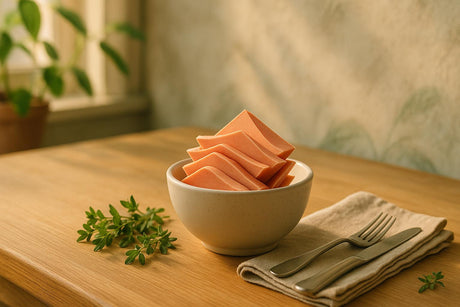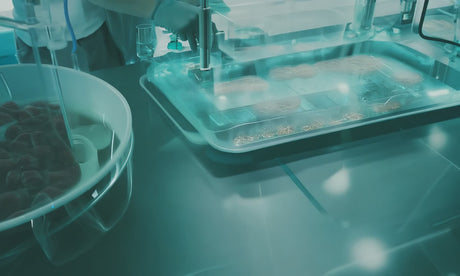Cultivated fat is transforming the taste and texture of lab-grown meat by addressing key elements that traditional meat lovers value. Here’s how it makes a difference:
- Juiciness and Texture: Fat ensures moisture retention and tender marbling, replicating the chew and juiciness of premium cuts.
- Aroma: Heated fat releases compounds that create the rich, meaty scent we associate with cooked meat.
- Natural Flavour Profiles: By mimicking the fatty acid composition of beef, pork, chicken, or lamb, cultivated fat delivers familiar flavours with precision.
- Cooked Flavours: It supports the Maillard reaction, enhancing browning and savoury notes during cooking.
- Taste Control: Controlled production reduces off-flavours and allows for tailored taste profiles.
These advancements ensure cultivated meat offers a consistent, flavourful experience, rivaling conventional options while allowing for customisation.
1. Improves Juiciness and Texture
Fat is essential in meat - it helps lock in moisture and boosts flavour. In cultivated meat, fat is carefully combined with muscle tissue to recreate that tender, juicy texture we associate with traditional cuts. During cooking, fat cells release triglycerides, which not only enhance flavour but also help retain moisture. This process mimics the natural marbling seen in high-quality cuts of meat.
Intramuscular fat is what gives premium meat its marbled appearance. This even distribution of fat creates layers that make the meat easier to chew, ensuring consistent tenderness with every bite. Achieving this balance is crucial for replicating the sensory appeal of conventional meat.
The controlled inclusion of fat also fine-tunes the overall texture and juiciness. By co-culturing fat and muscle cells, cultivated meat achieves that authentic marbling and rich, satisfying texture that meat lovers expect.
2. Creates Better Aroma Through Volatile Compounds
When cultivated fat is heated, it releases volatile compounds that produce the distinct, mouth-watering aroma we associate with meat. In cultivated meat, fat cells behave much like those in conventional meat, generating the aromatic molecules that make meat so appealing.
This process hinges on specific chemical reactions. When cultivated fat heats up, lipid degradation occurs. Essentially, fatty acids break down into smaller, volatile molecules that escape into the air, creating that unmistakable meaty scent.
Another key player in aroma development is the Maillard reaction. This chemical process happens when amino compounds interact with reducing sugars like ribose, which are found in both fat and muscle tissue. As the temperature climbs during cooking, this reaction intensifies, producing a mix of aromatic compounds that deepen the flavour and aroma of the meat.
What’s more, when fat and muscle are heated together, their compounds combine, forming new volatile molecules that take the aroma to the next level. This interaction ensures that cultivated meat delivers a rich and complex aroma, enhancing the overall sensory experience of eating it.
3. Produces Natural Flavour Profiles
Cultivated fat offers the ability to replicate the distinct flavour profiles of different meats by mimicking their specific fatty acid compositions. This means it can be tailored to deliver the familiar tastes of beef, pork, chicken, or lamb that we’ve come to expect.
Each type of meat owes its flavour to a unique combination of saturated and unsaturated fats. For instance, beef gets its rich taste from stearic and oleic acids, while pork’s milder, slightly sweet flavour comes from its higher linoleic acid content. Chicken, on the other hand, has a lighter taste thanks to its polyunsaturated fats. By understanding these chemical nuances, scientists can recreate these profiles with precision.
This is achieved by carefully controlling the nutrient composition in the growth medium used for fat cell cultivation. Adjusting the availability of fatty acids during this process allows for the creation of fat that closely matches the desired flavour profile. For example, cultivated beef fat can be designed to achieve the same palmitic, stearic, and oleic acid ratios found in traditional beef. Similarly, cultivated pork fat can be fine-tuned to reflect its natural linoleic acid levels.
Beyond simply replicating traditional flavours, this approach also allows for the enhancement of desirable taste compounds while reducing unpleasant ones. The result? Cultivated meat products that not only taste like their conventional counterparts but often surpass them by eliminating inconsistencies and unwanted elements.
This level of precision is a game-changer compared to conventional meat production, where flavour largely depends on factors like an animal’s genetics, diet, and environment - variables that are difficult to control and can lead to inconsistent results.
4. Supports Maillard Reactions for Cooked Flavours
The Maillard reaction is the magic behind the savoury aromas and rich browning we associate with perfectly cooked food. It happens when amino acids and reducing sugars interact under high heat, creating those mouth-watering flavours. Fat plays a key role in this process, acting as a flavour enhancer during cooking.
Cultivated fat takes this to the next level. As it melts, it creates the ideal dry, high-heat environment needed for a strong Maillard reaction. Its triglycerides and phospholipids [1] also contribute significantly to the overall sensory experience, influencing both taste and texture.
Thanks to this enhanced reaction, cultivated meat delivers deep, complex flavours that rival - or even surpass - traditional options.
sbb-itb-c323ed3
5. Reduces Off-Flavours and Allows Taste Control
One of the standout benefits of cultivated fat is its ability to cut down on off-flavours while giving producers precise control over taste. Unlike traditional animal fat - where flavour can vary depending on the animal's diet and environment - cultivated fat is grown in a controlled environment. This setup significantly reduces unwanted flavours and lets manufacturers fine-tune the flavour profile of cultivated meat.
This controlled production process enables the development of tailored flavour profiles through innovative techniques. Researchers Jin and Bao highlighted this potential, explaining:
"A new protocol can customize the flavor of cultivated meat by controlling the level of fat deposited between muscle cells. By altering the composition of cells generated during this process, researchers could make lab-grown meat that is personalized to an individual's taste." [2]
To achieve this level of flavour customisation, several methods are employed. For example, chemical interventions involve exposing differentiated muscle cells to specific amounts of fatty acids and insulin, allowing for precise control over intramuscular fat content [2]. Metabolic engineering takes it a step further by tweaking cellular pathways to boost the production of desired flavour compounds [3]. Additionally, genetic and epigenetic adjustments enable fine-tuning by regulating the activity of genes responsible for producing key flavour elements [3].
These advancements open the door to personalised cultivated meat products, designed to match individual taste preferences. Combined with the juiciness and aroma benefits mentioned earlier, this creates a more enjoyable and tailored eating experience.
Comparison Table
Here's a side-by-side look at how cultivated fat stacks up against conventional animal fat:
| Property | Cultivated Fat | Conventional Animal Fat |
|---|---|---|
| Juiciness Control | Provides more consistent fat distribution through precise cell culture techniques. | Varies based on factors like animal genetics, diet, and age. |
| Aroma Characteristics | Allows for controlled development of aroma compounds in a regulated setting. | Naturally influenced by rearing conditions, leading to variability. |
| Flavour Uniformity | Produced for uniformity using standardised processes. | Shows natural variations across different cuts of meat. |
| Off-Flavour Risk | Created under controlled conditions to reduce the likelihood of off-flavours. | Susceptible to off-flavours due to factors like diet and handling. |
| Maillard Reaction Support | Designed to ensure consistent browning during cooking. | Browning can vary depending on the fat's type and freshness. |
| Production Efficiency | Grown using cell culture methods, which are generally quicker than traditional farming. | Relies on longer animal growth cycles. |
| Customisation Potential | Can be tailored to meet specific taste or dietary needs. | Limited by the natural characteristics of animal biology. |
This table highlights the advantages of cultivated fat in terms of consistency and the ability to customise. For premium cuts, even fat distribution can elevate both juiciness and flavour. However, in processed products like ground meat, these benefits might be less noticeable. While conventional animal fat benefits from well-established production methods, cultivated fat is carving its niche with a different approach to cost and scalability.
Conclusion
To wrap up, cultivated fat is setting a new benchmark for meat flavour. By improving juiciness, enhancing browning, and ensuring consistent flavour through meticulously designed fat distribution, it transforms the quality of meat while reducing undesirable off-tastes.
As cultivated meat edges closer to becoming a reality in the UK market, understanding these advancements in flavour becomes all the more relevant. The controlled production process ensures that every bite delivers a premium taste experience, avoiding the inconsistencies often found in traditional meat production.
For those eager to learn more, Cultivated Meat Shop is an excellent resource. It offers detailed insights into how cultivated meat is produced, its advantages, and what to expect as these products hit the shelves. Whether you're a passionate foodie, someone mindful of sustainability, or just intrigued by this cutting-edge food innovation, the platform provides the information you need to explore this exciting new category of meat.
The journey to redefining meat flavour is happening now, with cultivated fat leading the way to a consistently delicious future.
FAQs
How does cultivated fat enhance the juiciness and texture of cultivated meat compared to traditional meat?
Cultivated fat is key to enhancing the juiciness and texture of cultivated meat, closely imitating the role fat plays in traditional cuts. It locks in moisture and delivers that rich, satisfying mouthfeel people expect, making the eating experience almost identical to conventional meat.
By recreating the sensory qualities of natural fat, cultivated fat ensures that cultivated meat hits the mark on both flavour and texture, providing a tasty and convincing option for meat enthusiasts.
How does the Maillard reaction enhance the flavour of cultivated meat, and what role does cultivated fat play in this process?
The Maillard reaction is central to the mouth-watering, savoury flavours we link with cooked meat. When heat is applied, it triggers a reaction between amino acids and sugars, creating complex flavour compounds and that unmistakable, appetising aroma.
Cultivated fat is crucial in this process, supplying key elements like amino acids and reducing sugars. These ingredients combine during cooking to deliver the signature taste and succulence of cultivated meat, bringing it closer to the flavour and texture of traditional meat.
Can cultivated fat be tailored to enhance the flavour of different types of meat, and how is this achieved?
Cultivated fat can be fine-tuned to bring out the distinct flavour profiles of various meats. By tweaking the biochemical processes during its creation, it can mimic the specific taste and aroma of meats like beef, pork, or chicken.
This precision comes from adjusting factors such as cell culture conditions and the nutrient mix, which directly impact the flavour compounds in the fat. Beyond enhancing richness and juiciness, cultivated fat is crucial in recreating the familiar taste that people associate with their favourite meats.
To dive deeper into the world of cultivated meat and its role in reshaping sustainable eating, check out Cultivated Meat Shop for more information and insights into this innovative food category.













